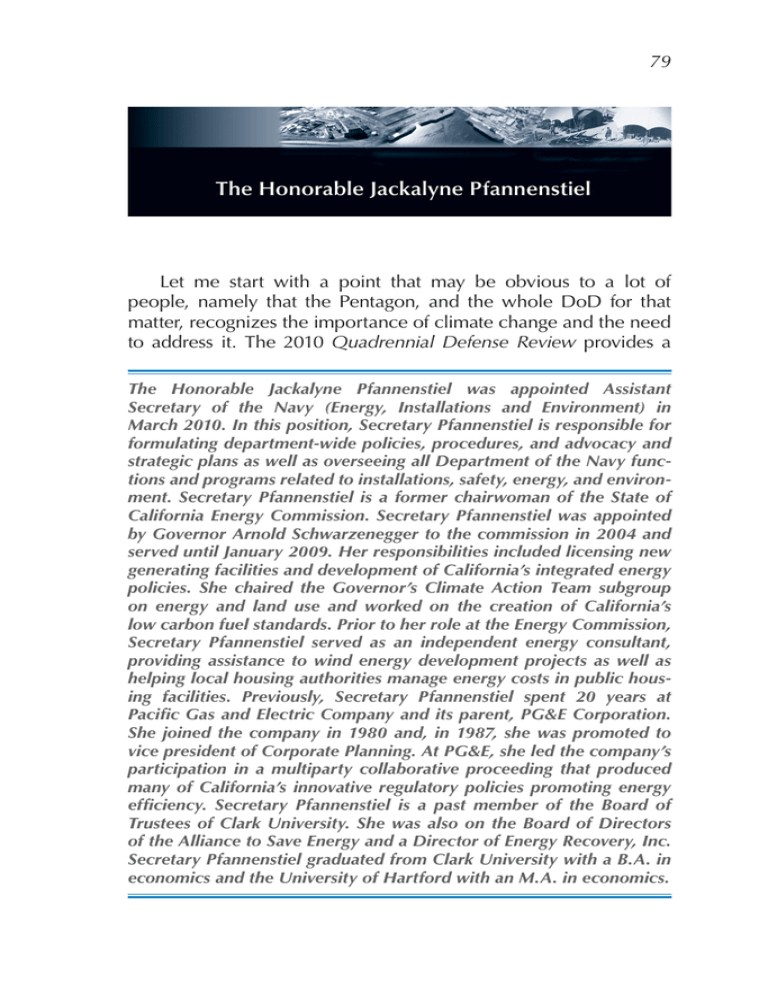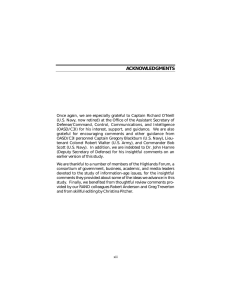The Honorable Jackalyne Pfannenstiel
advertisement

79 The Honorable Jackalyne Pfannenstiel Let me start with a point that may be obvious to a lot of people, namely that the Pentagon, and the whole DoD for that matter, recognizes the importance of climate change and the need to address it. The 2010 Quadrennial Defense Review provides a The Honorable Jackalyne Pfannenstiel was appointed Assistant Secretary of the Navy (Energy, Installations and Environment) in March 2010. In this position, Secretary Pfannenstiel is responsible for formulating department-wide policies, procedures, and advocacy and strategic plans as well as overseeing all Department of the Navy functions and programs related to installations, safety, energy, and environment. Secretary Pfannenstiel is a former chairwoman of the State of California Energy Commission. Secretary Pfannenstiel was appointed by Governor Arnold Schwarzenegger to the commission in 2004 and served until January 2009. Her responsibilities included licensing new generating facilities and development of California’s integrated energy policies. She chaired the Governor’s Climate Action Team subgroup on energy and land use and worked on the creation of California’s low carbon fuel standards. Prior to her role at the Energy Commission, Secretary Pfannenstiel served as an independent energy consultant, providing assistance to wind energy development projects as well as helping local housing authorities manage energy costs in public housing facilities. Previously, Secretary Pfannenstiel spent 20 years at Pacific Gas and Electric Company and its parent, PG&E Corporation. She joined the company in 1980 and, in 1987, she was promoted to vice president of Corporate Planning. At PG&E, she led the company’s participation in a multiparty collaborative proceeding that produced many of California’s innovative regulatory policies promoting energy efficiency. Secretary Pfannenstiel is a past member of the Board of Trustees of Clark University. She was also on the Board of Directors of the Alliance to Save Energy and a Director of Energy Recovery, Inc. Secretary Pfannenstiel graduated from Clark University with a B.A. in economics and the University of Hartford with an M.A. in economics. 80 Climate and Energy Proceedings 2011 good discussion of the worldwide vulnerabilities to climate change, including the geopolitical consequences, poverty, environmental degradation, humanitarian consequences, food and water scarcity, spreading of diseases, mass migrations, and the physical consequences—rainfall, temperature, thawing permafrost, earlier snowmelt, and alterations in river flow. [1] Based on this, the report concludes that these consequences can lead to increased demand for humanitarian assistance and disaster response. So, the whole DoD recognizes this. The Department of the Navy is thinking along the lines of the vulnerabilities that we face. Fundamentally, what we are thinking is that climate change may well affect our mission readiness. The areas within the United States that are most vulnerable to the effects of sea-level rise and storm surge are New Orleans and the Hampton Roads area of Virginia where we have an enormous concentration of naval bases. We know that sea level is rising; we have documented that. We also have the potential for flooding, for greater storm damage, and for shoreline erosion. Given our facilities on the coast, climate-caused changes could have an incredible impact on our future readiness. We also know that a hotter and drier climate in the Southwest, for example, is going to affect water availability. We know that we can expect weather extremes in the Southeast. All of these changes have the potential to affect our training and our testing on our installations. So the Navy has two ways of looking at it: mitigation strategies and adaptation strategies. Our mitigation strategies are fundamentally our aggressive energy goals. I know that Rear Admiral Philip Cullom talked about them earlier, but let me just emphasize the fact that we are viewing energy as mission critical—it is what we need to do our mission. We also need to protect our bases from supply shortages, from volatility, and from grid outages, and we are doing that not just because it is the right environmental action to take, but because it is in the nation’s interest and is part of our national defense mission. As you are aware, the Secretary of the Navy has set some very aggressive energy goals, two of which I will mention because they will make a big difference. One is that by 2020, half of the energy Chapter 3 Adapting Infrastructure to Climate Challenges 81 that the Department of the Navy uses will come from non-fossil fuel sources. Given the fact that 75% of the energy that we use now is used for operations in ships, planes, and tactical vehicles, that is a big challenge. Another goal that he has issued is that by 2020, half of our Navy and Marine installations will be zero net energy. They will produce as much energy as they use. So what does that mean? Well, from a fossil fuel standpoint, it means we will use less, and it means that our contribution to greenhouse gasses will be that much less. So that is what we are thinking about in mitigation; that is where we are going. Can the Department of the Navy alone make a difference in the United States? Our greenhouse gas emissions will not make the difference, but if we model how energy can be used and how to build a more energy efficient base and a more energy efficient community, then yes, we can make a difference. The adaptation strategy is fundamentally about building sustainable infrastructure. That means continuing to build our energyefficient bases using the technologies and the practices that will help us meet the Secretary’s goals. It also means that we need to look at adaptation for both the long and short run. The DoD together with the Environmental Protection Agency and the Department of Energy has launched the Strategic Environment Research and Development Program (SERDP), which is doing a series of studies that look at our military bases. They are looking both at vulnerabilities and at the set of tools that our bases and installations can use to meet certain climate events. By postulating specific climate events such as storm surge and sea-level rise in specific years, they are examining how base commanders may be able to deal with those events. When completed, those studies will give us a series of tools that we can use for all of our bases. We have already started going to each individual Navy and Marine Corps base to look at the specific vulnerabilities to climate change effects and to see what tools will be needed. One of the conclusions that we have already drawn is that we need to be holistic. We do not stand alone. Our bases are not separate from their communities. Our bases rely on the local power grid; they rely on the local transportation system; 82 Climate and Energy Proceedings 2011 they worry about the food supply. So, to the extent that our bases are developing strategies, those strategies need to include the greater community. That means sharing information back and forth with the community, and it means preparing our infrastructure on an expanded basis. Task Force Climate Change draws on the talents of some 600 U.S. government employees, not just across the military but across other parts of the government. There are other task forces that have grown up on both the East and West Coasts with local communities working with the science community, government, business, and academia to look at local area climate effects and adaptation strategies. That is true in the Virginia area, and it is true on the West Coast where this is something that has come up not because it was required and not because it was structured by government per se, but rather because it is the communities who are worried. The Department of the Navy is involved in these activities and is both providing information and helping to develop appropriate strategies. The fact that such collaborations are happening, I think, leads to the conclusion that communities are looking for a national strategy and are looking for some leadership at the national level to make sure that all of the various risks are being assessed and that the infrastructure is being built to be adaptable. The question then becomes: who will pay for adaptation? Who will pay to build the levees or to move bases where we decide that they need to be moved? From the perspective of the Department of Navy, this investment needs to be part of our overall readiness. We need to do this because we need to be militarily ready and so that is part of the investment that we would make in national defense. But in fact, if the American public does not believe that climate change is happening, should we really expect that Congress is going to fund whatever adaptation strategies we might develop? REFERENCE 1. Department of Defense, 2010 Quadrennial Defense Review, 2010, http://www.defense.gov/qdr/images/QDR_as_of_ 12Feb10_1000.pdf.

